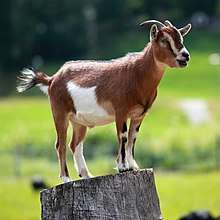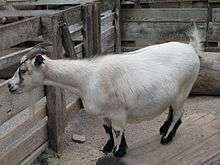Pygmy goat


The African pygmy goat is a breed of miniature domestic goat. The pygmy goat is quite a hardy animal, and can adapt to virtually all climates.[1]
Appearance
Nannies weigh 24 to 34 kg (53 to 75 lb), while billies weigh 27 to 39 kg (60 to 86 lb). Wither height ranges from 41 to 58 cm (16 to 23 in). In the U.S., pygmies come only in seven breed standard approved colors, and can be categorized into caramel patterned, agouti patterned, and black patterned. Within these categories, there are caramel with black markings, caramel with brown markings, brown agouti, grey agouti, black agouti, black with white markings, and solid black. The faulting matrix allows for faulting random white markings from moderate to very serious, and these animals will be judged accordingly. White belly bands are not considered random markings. The eyes of the pygmy goat come only in brown.[2][3]
Reproduction
Pygmy goats are precocial and polyestrous breeders, bearing one to four young every nine to 12 months after a five-month gestation period. Does are usually bred for the first time at about 18 to 24 months, although they may conceive as early as two months if care is not taken to separate them early from male kids. Breeding under-age does often results in C-sections. Newborn kids will nurse almost immediately, begin eating within a week, and are weaned by ten weeks of age.
Kidding
Pygmy goats are just like any other variation of other goat breeds when it comes to kidding. Kidding is the process when the doe is physically giving birth to her kids, also known as the new born goats themselves. The doe will usually start showing signs around 2 to 3 days prior to labor, but in some cases, the doe will show no signs and have her kids with no problems. Goats are known for not really needing assistance when kidding time comes around, but it is always a good idea to plan ahead. There are multiple positions that the kid can try and come out that will cause many difficulties for the doe. The kid should always come out head first along with the two front hooves. If the kid is not coming out in this orientation, the action of having to glove up and reset the kids position may take place. There are multiple positions the kid can come out in that will cause difficulties for the doe. For the head first with one or both legs back, all that has to be done is find the legs and pull them forward. Once they are forward, the mother should be able to finish birthing on her own. For both legs out, head turned back or down, just find the head and pull it forward to help the doe through the kidding process. The breech is known as the impossible birth, and the kid must be pushed back into the uterus to rearrange its position. One should always be careful not to tear any of the doe’s interior, or that we lead to more complications. And finally, the last possible complication includes the multiples coming out together. For this, an evaluation must take place on which twin will require the least amount of manoeuvring and pull that one out first. If any of these procedures take longer than 15 minutes, call a veterinarian right away and make sure that the doe is alright. After the birth takes place, the placenta should pass within an hour after the kidding. If it does not pass, call a vet. If the placenta is not removed from the mother’s area, she will most likely end up eating it. It will neither benefit or harm the doe if she eats the placenta.
Origin
The pygmy goat was developed from the West African dwarf goat, a landrace of Central and West Africa, found most commonly in the Cameroon Valley. They were taken to Europe primarily by the British during the colonial era. A few hundred were later exported to the United States from Europe in the 1950s for use in zoos and for their milk as well as to be used in lab research. They were eventually acquired by private breeders and quickly gained popularity as pets and as exhibition animals owing to their small size, good-natured personalities, friendliness and hardy constitution.[4] Pygmy goats are the most common breed of goat kept as pets.[5]
Housing and care
Pygmy goats are adaptable to most climates. Their primary diet consists of greens and grains. They enjoy having items to jump on and may be able to leap onto small vehicles. They are also in need of a shed and open area accessible at all times. They also need a companion, which doesn't necessarily have to be its own species. They are prey animals and should therefore be sheltered in a predator-proof area, especially at night. Goats require fresh water at all times or they won't drink it. Pygmy goats are often affectionate if they are treated with respect. They can also be trained, though it requires quite a bit of work. It is important to make sure pygmy goats are comfortable and warm during the winter months.[6] Simple measures such as feeding pygmy goats lukewarm water and lukewarm food, as well as ensuring their living quarters are free from drafts, can make pygmy goats a lot happier during the winter.[7]
General information
- Scientific name: Capra aegagrus hircus[8]
- Average lifespan: 8–18 years.
- Normal body temperature: 101.5-104 °F (39.1 - 40 °C)
- Normal pulse rate: 60-90 beats per minute (faster for kids)
- Normal respiration rate: 15-30 per minute
- Rumen movement: 1-1.5 per minute
- Gestation period: 145–155 days (average 150 days)
- Heat (oestrus) cycle: 18–24 days (average 21 days)
- Length of heat: 12–48 hours (average 1 day)
- Weaning age (recommended): 8–10 weeks
- Males sexually mature: 9–12 weeks
- Females onset of heat: 3–12 months*
- Dehorning (by veterinary surgeon): By 7 weeks
- Castration:
- Using elastrator ring: 8 weeks and older (recommended to limit risk of Urinary Calculi)
- Surgical method (by vet): No age limit
References
- ↑ Colby, Brian, et al. Dairy goats-breeding/feeding/management. American Goat Society. 1972.
- ↑ National Pygmy Goat Association. Best of Memo I. 1982.
- ↑ National Pygmy Goat Association. "Color Choices for Registration". 2013.
- ↑ National Pygmy Goat Association "Pygmies For All Reasons". 2003.
- ↑ "Pygmy Goats: Everything You Need to Know About the Breed". Wide Open Pets. 2017-08-19. Retrieved 2018-06-30.
- ↑ David Watts. "Pet Pygmy Goats: Henry and Joey". henryandjoey.co.uk. Retrieved 11 December 2014.
- ↑ Kinne, Maxine. Pygmy goat care and management. 1987.
- ↑ "Speciality Livestock - Agriculture.com". agriculture.com. Retrieved 11 December 2014.
External links
| Wikimedia Commons has media related to Pygmy goats. |